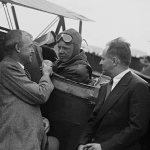 Technology
Technology  Technology
Technology  Humans
Humans 10 Everyday Human Behaviors That Are Actually Survival Instincts
 Animals
Animals 10 Animals That Humiliated and Harmed Historical Leaders
 History
History 10 Most Influential Protests in Modern History
 Creepy
Creepy 10 More Representations of Death from Myth, Legend, and Folktale
 Technology
Technology 10 Scientific Breakthroughs of 2025 That’ll Change Everything
 Our World
Our World 10 Ways Icelandic Culture Makes Other Countries Look Boring
 Misconceptions
Misconceptions 10 Common Misconceptions About the Victorian Era
 Mysteries
Mysteries 10 Strange Unexplained Mysteries of 2025
 Miscellaneous
Miscellaneous 10 of History’s Most Bell-Ringing Finishing Moves
 Technology
Technology Top 10 Everyday Tech Buzzwords That Hide a Darker Past
 Humans
Humans 10 Everyday Human Behaviors That Are Actually Survival Instincts
 Animals
Animals 10 Animals That Humiliated and Harmed Historical Leaders
Who's Behind Listverse?

Jamie Frater
Head Editor
Jamie founded Listverse due to an insatiable desire to share fascinating, obscure, and bizarre facts. He has been a guest speaker on numerous national radio and television stations and is a five time published author.
More About Us History
History 10 Most Influential Protests in Modern History
 Creepy
Creepy 10 More Representations of Death from Myth, Legend, and Folktale
 Technology
Technology 10 Scientific Breakthroughs of 2025 That’ll Change Everything
 Our World
Our World 10 Ways Icelandic Culture Makes Other Countries Look Boring
 Misconceptions
Misconceptions 10 Common Misconceptions About the Victorian Era
 Mysteries
Mysteries 10 Strange Unexplained Mysteries of 2025
 Miscellaneous
Miscellaneous 10 of History’s Most Bell-Ringing Finishing Moves
Lost in Transmission: 10 Unsung Heroes of Radio Innovation
Radio has been more than just a source of entertainment; it has been a lifeline, a revolutionary force, and a quiet backdrop to some of the most pivotal moments in history. But behind the iconic broadcasts and familiar voices are the untold stories of innovation, ambition, and the unsung heroes who pushed the boundaries of what radio could be. Consider the daring broadcast of Atlantic 252, a small station from Ireland that shook the UK radio landscape, or the SSTR-1, the portable radio that became the unsung hero of World War II espionage, keeping Allied spies connected behind enemy lines.
In this list, we delve into ten often-overlooked radio projects that played crucial roles in shaping the medium as we know it today. From Carl Malamud’s groundbreaking leap into internet radio to the rebellious defiance of Laser 558, these innovations might not have made headlines. Still, without them, the radio world would be vastly different. Each one represents a moment of ingenuity, a leap of faith, and a story worth telling.
So let’s tune in to these hidden frequencies, uncovering the lost signals that have subtly but profoundly influenced the course of radio history. These projects, often overshadowed, were vital in the evolution of communication, making them the true unsung heroes of the airwaves.
Related: 10 Inventive Ways People Survived Winter Before Electricity
10 The 1920s Radio Boom: A Revolution in the Airwaves
In the 1920s, radio wasn’t just a new gadget—it was a revolution in how people experienced the world. As radios began popping up in homes across America, they brought a wave of change that few could have predicted. Suddenly, voices and music could travel across the country, knitting together a nation that had previously been divided by regional differences. It was a time when radio didn’t just entertain—it connected people in ways that newspapers and telegraphs never could.
This wasn’t just about tuning in to your favorite show. The economic boom of the 1920s gave families the means to invest in this new technology, and they did so with enthusiasm. Radio programs like Amos ‘n’ Andy became national phenomena, while sports broadcasts turned athletes into household names. But beneath the surface, radio was quietly shaping a shared American identity, one broadcast at a time.
Yet, for all its impact, the true heroes of this radio revolution remain largely unsung. The innovators who made it all possible are often lost in the static of history. But without their contributions, the radio might never have become the cultural powerhouse it did, forever changing how we communicate and connect with the world around us.[1]
9 Crosley Pup: The Affordable Radio That Changed Everything
In the 1920s, radios were seen as luxury items, out of reach for the average family. But Powel Crosley Jr. wasn’t one to accept that status quo. After being shocked by the high prices of radios, he decided to build one himself—and then realized he could make radios affordable for everyone. The result was the Crosley Pup, a simple, one-tube radio that hit the market in 1925 for just $9.95. This little device wasn’t just cheap; it was a game-changer, bringing radio into homes that had never before imagined they could afford it.
Crosley didn’t stop at making radios more accessible. He understood that the more people who could tune in, the more radios he could sell. This led him to build WLW, which would become the most powerful radio station in the United States. Broadcasting at a staggering 500,000 watts, WLW could be heard across the country, making Crosley radios even more valuable to their owners.
While many may not remember Powel Crosley Jr.’s name today, his contributions to radio innovation are undeniable. The Crosley Pup wasn’t just a product; it was a catalyst for change, making radio a part of everyday life for countless Americans. His vision and determination made him a true unsung hero of radio’s early days, forever altering the way we connect with the world.[2]
8 Ernst Alexanderson: The Engineer Who Brought Voices Across Oceans
Ernst Alexanderson might not be a household name, but his work on long-distance radio communication changed the world. Born in Sweden in 1878, Alexanderson brought his talents to America, where he made history with the invention of the high-frequency alternator. This game-changing device allowed for continuous radio waves, making it possible to transmit music and voices rather than just Morse code. On Christmas Eve 1906, his alternator powered the first-ever radio broadcast that included both singing and conversation, a monumental step forward for global communication.
But Alexanderson’s impact didn’t stop there. His alternators were key to Guglielmo Marconi’s transatlantic broadcasts during World War I, reaching audiences across Europe. In 1918, President Woodrow Wilson used one of Alexanderson’s creations to send a powerful message to Germany, helping to bring an end to the war. These achievements made Alexanderson’s innovations crucial in connecting people across vast distances when it mattered most.
Yet, despite these significant contributions, Alexanderson’s name is often overlooked in the story of radio. His work paved the way for the radio and television systems we rely on today, making him one of the true unsung heroes of radio innovation.[3]
7 The Empire Wireless Chain: Connecting a Far-Flung Empire
In the early 1900s, as the British Empire stretched across the globe, maintaining communication with its far-flung colonies was no small feat. Enter the Imperial Wireless Chain, a bold vision by Guglielmo Marconi to link the empire through a network of shortwave radio stations. Though conceived in 1906, the project faced setbacks due to political scandals and the outbreak of World War I. But by the 1920s, Marconi’s innovative ‘beam’ system brought the idea back to life, connecting Britain with Canada, Australia, India, and beyond.
These stations weren’t just about keeping in touch—they were about control. The Imperial Wireless Chain became a vital tool in holding the empire together, allowing Britain to project its influence across continents. It even posed a serious threat to the older submarine cable systems, forcing a merger that created the giant telecommunications firm Cable and Wireless.
Despite its pivotal role, the story of the Imperial Wireless Chain often fades into the background, overshadowed by other innovations. Yet, this network was a lifeline for the British Empire, making it one of the true unsung heroes of radio innovation.[4]
6 The Arc Transmitter: The Lost Lifeline of the Titanic
In the early days of radio, Valdemar Poulsen’s arc transmitter was a game-changer. This device, known for its ability to send smooth, continuous radio waves, offered a huge leap forward from the clunky, unreliable “spark gap” transmitters of the time. Poulsen’s innovation allowed multiple signals to be sent at once, making it possible for radio operators to communicate more effectively, even over long distances. It was a remarkable piece of technology, but it arrived too late for one of history’s greatest tragedies.
When the Titanic set sail in 1912, it was equipped with outdated spark gap transmitters. These could only handle one message at a time, leaving the ship’s radio operator overwhelmed and missing crucial iceberg warnings. The arc transmitter, with its ability to manage multiple frequencies, could have made a difference—possibly even saving lives. But the Titanic’s fate was sealed by the limitations of its technology, a tragic example of what might have been.
Though its potential was overlooked in the Titanic disaster, the arc transmitter eventually became the backbone of commercial wireless communication by the 1920s. It’s a piece of history that quietly revolutionized radio, making it one of the true unsung heroes of radio innovation.[5]
5 Atlantic 252: Ireland’s Quiet Revolution on the Airwaves
In the late 1980s, Ireland made waves—quite literally—across the UK with the launch of Atlantic 252. This longwave pop station, a joint venture between RTÉ and European media giant RTL, started broadcasting from an 800-foot (244-meter) mast in Clarkestown, Ireland. Despite the dominance of FM radio, Atlantic 252 became an unexpected sensation, drawing in millions of listeners with its tightly curated hit music playlist. By the early ’90s, it had overtaken major UK stations to become the most listened-to commercial radio station in Britain.
Atlantic 252 wasn’t just another station; it was a disruptor. Broadcasting on a longwave frequency, it defied the odds, proving that great content could attract audiences regardless of the medium. Its success rattled the UK radio industry, which had underestimated the power of this Irish upstart. For a generation of listeners, especially younger ones, Atlantic 252 was more than just music—it was a connection to something bigger, a shared experience that transcended borders.
Although Atlantic 252 eventually faded with the rise of digital media, its impact on the radio landscape was undeniable. It’s a reminder of how a small station from a field in Ireland managed to connect with millions, leaving an indelible mark on the history of radio broadcasting.[6]
4 The Unseen Impact of Radio Luxembourg
Radio Luxembourg was more than just another station on the dial—it was a lifeline for a generation eager for something fresh and rebellious. Launched in 1933, this English-language broadcaster quickly became a household name across Europe. Known as “The Station of the Stars,” it delivered the latest rock and pop hits to listeners far beyond the UK’s reach. While many tuned in for the music, they also found a sense of connection and freedom, especially in countries where the airwaves were otherwise tightly controlled.
During the 1950s and 1960s, Radio Luxembourg’s broadcasts broke through the iron grip of government-controlled media. It became the soundtrack of youth, introducing them to new sounds and ideas that were often considered too edgy for traditional outlets. The station’s reach wasn’t just a matter of geography—it crossed ideological boundaries, bringing a breath of fresh air to listeners on both sides of the Iron Curtain.
Despite its enormous influence, Radio Luxembourg remains an unsung hero in the history of radio innovation. It wasn’t just the music that made it special; it was the spirit of defiance and creativity that resonated with millions. Though it eventually went off the air in 1992, the station’s legacy lives on, a testament to the power of radio to inspire and unite across borders.[7]
3 The Lifeline in a Suitcase
In the clandestine world of World War II espionage, the SSTR-1 was the unsung hero that helped turn the tide. Developed in 1942 by the Office of Strategic Services (OSS), this small, portable radio transmitter-receiver was a lifeline for Allied spies and resistance fighters deep behind enemy lines. The SSTR-1’s genius lay in its simplicity and adaptability—compact enough to fit inside a suitcase, it was easy to transport and quick to set up, making it invaluable for operatives who had to move fast and stay hidden.
The SSTR-1 was more than just a piece of equipment; it was a silent partner in countless missions. With the ability to run on various power sources, including car batteries, it could operate in the most challenging conditions, from the occupied cities of Europe to the jungles of the China-Burma-India theater. This rugged device allowed brave men and women to transmit crucial intelligence, often risking their lives to keep the lines of communication open between the front lines and Allied command.
Even after the guns fell silent, the SSTR-1’s legacy endured. During the early Cold War years, it continued to serve in Europe’s Stay-Behind networks, a grim reminder of the ever-present threat of Soviet invasion. Though overshadowed by more famous wartime innovations, the SSTR-1’s quiet reliability made it a true hero of radio technology, a device that played a vital role in securing victory and preserving freedom.[8]
2 The Birth of Internet Radio: Carl Malamud’s Unsung Vision
In the early 1990s, the idea of streaming audio over the internet was almost unimaginable, but Carl Malamud had a different vision. As a computer engineer, Malamud saw potential in the internet as a medium for broadcasting. In 1993, he launched Radio HK, widely considered the first internet radio station. Though the station was short-lived, Malamud’s pioneering effort laid the groundwork for what would become a global phenomenon. His work demonstrated that the internet could do more than just share information; it could be a platform for creativity and connection, breaking down the barriers of traditional radio.
Despite the technical limitations of the time—like slow internet speeds and costly setups—Malamud’s initiative sparked a revolution. He offered a mix of music, news, and other content that was accessible through a basic web browser, opening the door to a new era of radio. While few could listen in those early days, Malamud’s Radio HK proved that the internet was more than just a passing fad—it was the future of broadcasting.
Today, internet radio is a staple in the world of media, accessible from nearly any device and location. But it all began with Malamud’s unsung innovation, a quiet revolution that transformed how we connect with music, news, and each other across the globe.[9]
1 Laser 558: The Pirate Radio That Defied the Odds
In 1984, Laser 558 set sail, literally and figuratively, into the heart of the European radio scene. Broadcasting from the MV Communicator, an offshore ship anchored in international waters, this pirate radio station quickly captivated millions across the UK and Europe. With its American DJs spinning a relentless stream of hits, Laser 558 offered an escape from the speech-heavy formats that dominated British airwaves. The station’s powerful signal, carried by state-of-the-art transmitters, made it a beloved and rebellious presence for listeners tired of the status quo.
However, Laser 558’s success was met with fierce resistance. The station’s secretive funding and its knack for outmaneuvering legal restrictions alarmed the UK government and commercial radio operators. Rumors swirled, including wild speculations about IRA involvement, which only added to the station’s enigmatic allure. The authorities resorted to blockading supplies to the ship, hoping to cut off its lifeline. Despite these efforts, Laser 558 managed to stay afloat for a while, even using helium balloons to keep its antenna aloft—a testament to its ingenuity and determination.
But in the end, the relentless pressure proved too much. By late 1985, with its resources depleted and its generators failing, Laser 558 was forced to surrender. The ship was seized, and the station that had once defied the odds was silenced. Yet the legacy of Laser 558 lives on, a symbol of the power of innovation and the enduring appeal of radio that dares to challenge the norm.[10]








